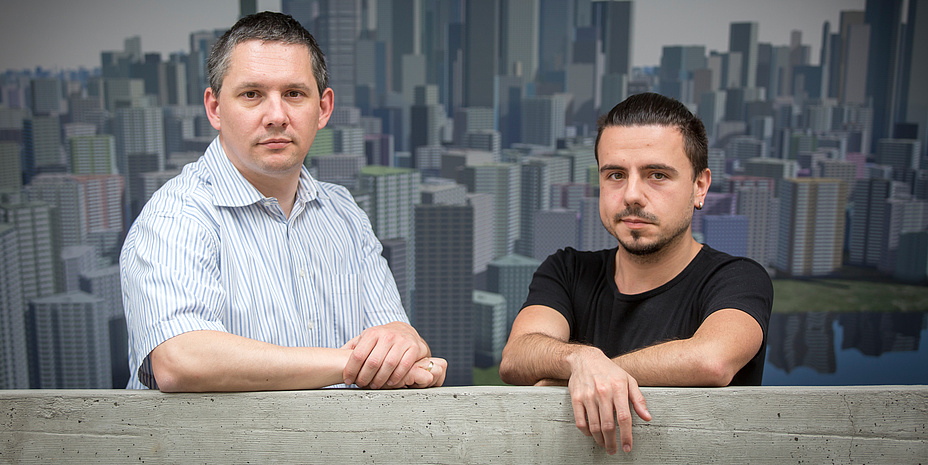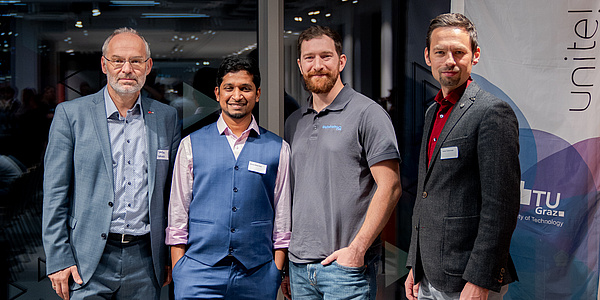You’re working with augmented reality – what exactly does it mean?
This can be explained easily by juxtaposing data glasses, for example Google’s smart glasses, to augmented reality. If I look at the Mona Lisa with data glasses, I will be presented with explanatory text in my field of vision. However, visual augmented reality goes far beyond that – it adds to and changes the reality perceived with a mobile telephone or a head-mounted display (HMD). Let me illustrate this with an example. With visual augmented reality we are able to draw a long nose on Mona Lisa, virtually and in real time, and we can seamlessly integrate the manipulation into the displayed augmented reality.
With visual augmented reality we are able to draw a long nose on Mona Lisa.
But you’re not working on manipulating the Mona Lisa?
In November 2015 I set up AR4.IO. We specialized in applications in large industrial enterprises that currently available solutions do not cover. Augmented reality can be used for training, product documentation or problem solutions. An example. If you have to perform sensitive maintenance work on a remote oil rig, a person who is adequately skilled but does not have special know-how is nevertheless able to perform the work if he or she wears smart glasses, because the smart glasses recognize all parts of the equipment as well as the spare parts and indicate the correct working procedure to the wearer of a HMD, or provide the relevant information on a smartphone.
So can augmented reality solutions replace expert know-how for a company?
No. But it can cut out travelling costs for the expert. Nevertheless, experts are still needed to develop the data for the maintenance and the working steps to solve the problems. It is just that they do not have to be personally on site or fly halfway around the globe only to sort out a possibly minor problem.
But could you not do this by video telephony?
In some cases it will be enough to take a photograph or film the problem. However, if complex problems are involved, if the internet connection is not good enough or if there are security concerns, video telephony is inadequate. Augmented reality is the communication type that directly follows video telephony. But as a society we still have to get used to and embrace it.
Augmented reality is the communication type that directly follows video telephony.
Data protection is an important issue, especially in big industrial enterprises. How do you deal with that?
We already have very good mainstream solutions in the mass market for applications such as gaming or training. Theses involve servers set up in another country, but there is no way of knowing what exactly happens with the data. Of course, this is a no-go area for industrial companies. Because of this, we are working on solutions that provide a database with more than 100,000 image datasets autonomously, without internet connection. These data never leave the company. Also, it would be wrong to assume that internet coverage is adequate everywhere. Another problem of the mainstream solutions is that they have been designed to distinguish between a large number of very different things. But our objective is to design solutions that are capable of distinguishing between many very similar things – for instance different types of screws.
You and your company AR4.io were recently chosen as participants of the “Go Silicon Valley” programme of the Chamber of Commerce. What are your expectations from this stay?
We will work in “Plug & Play”, the largest start-up centre in Silicon Valley, for three months and participate in a business initiation programme. One of our objectives is to get our foot in the door outside Europe, in the USA. You can only do this if you have an office there. During the first three months we want to establish contacts and engage in various networks. We are convinced that we are working on an outstanding technology that will gain recognition. Finally, I have the same dream as probably every other founder of a company. I eventually want to sell the company, retire and buy a Tesla. (laughs)
Clemens ARTH
Dipl.-Ing. Dr.techn.
Institute for Computer Graphics and Vision
Inffeldgasse 16/II
8010 Graz, Austria
Phone: +43 316 873 5028
Fax: +43 316 873 5050
<link int-link-mail window for sending>clemens.arth@tugraz.at





